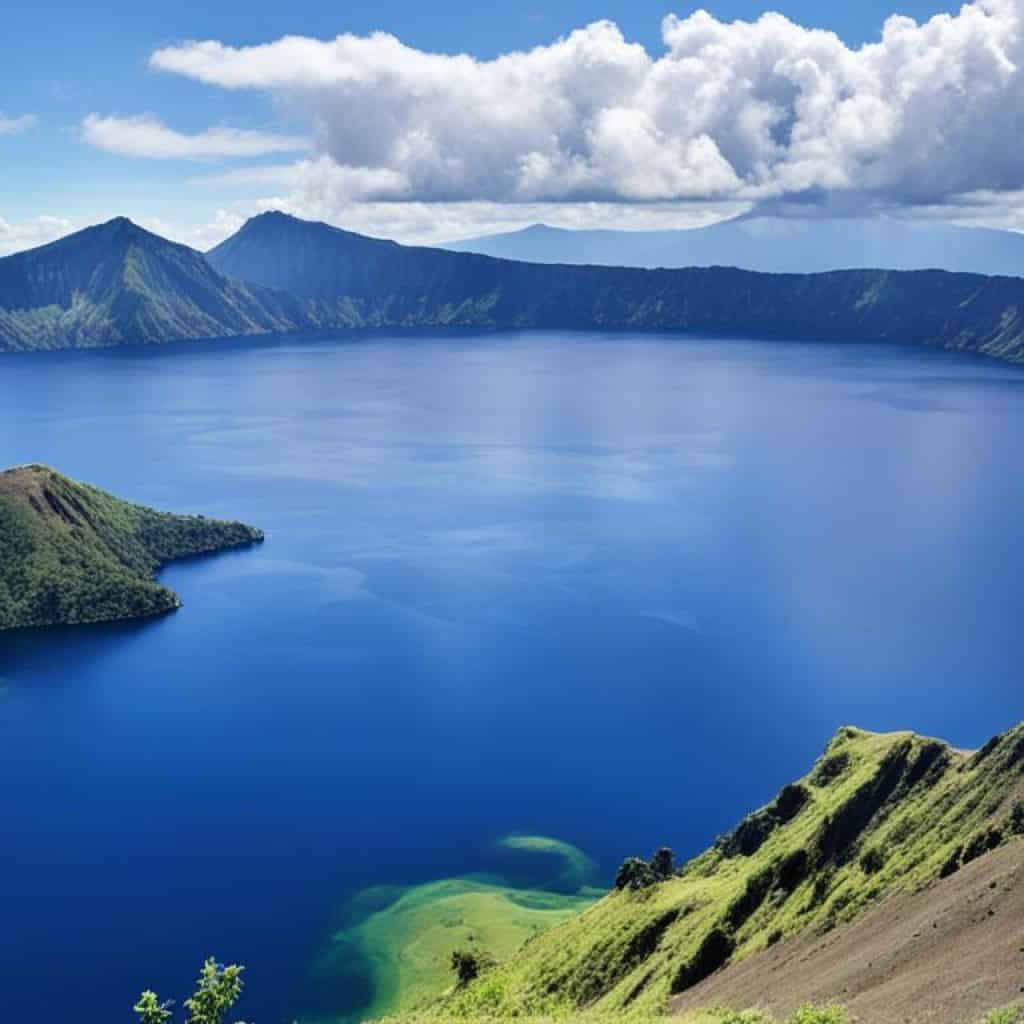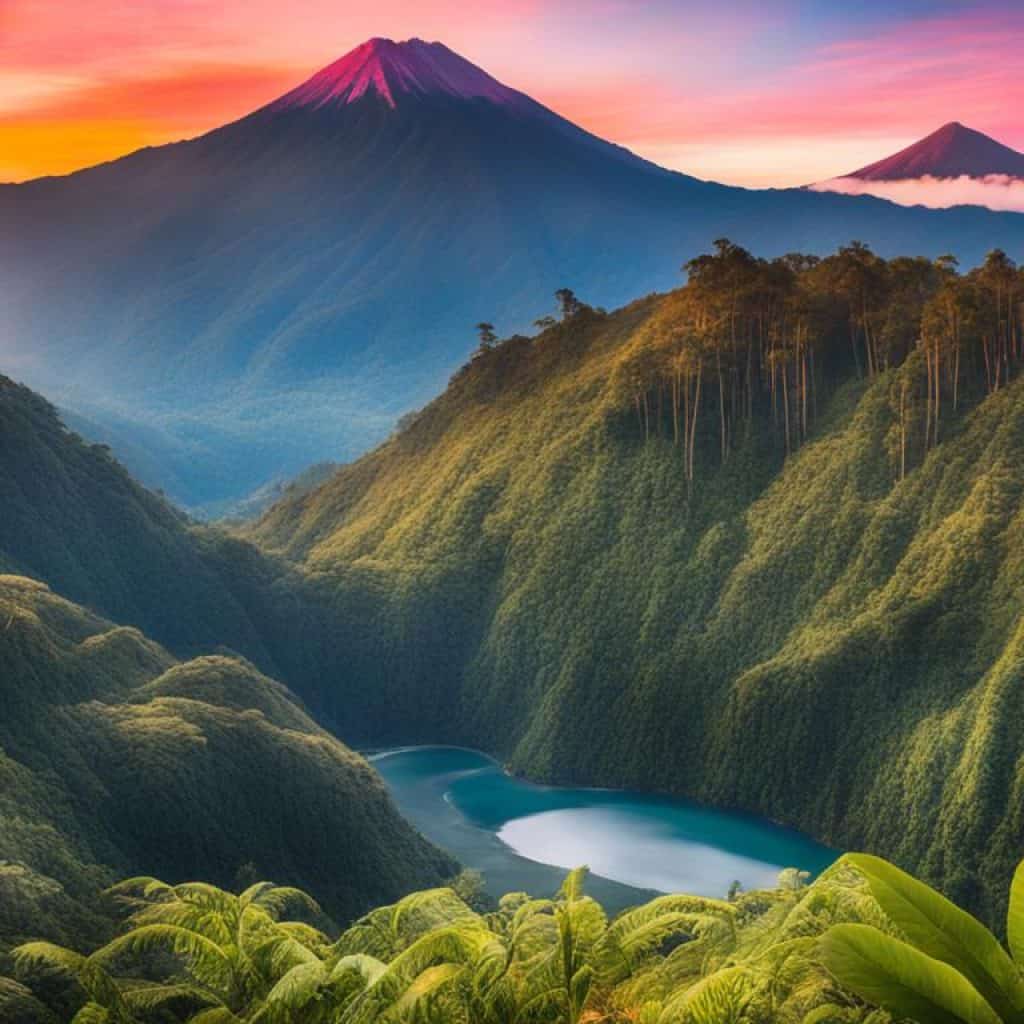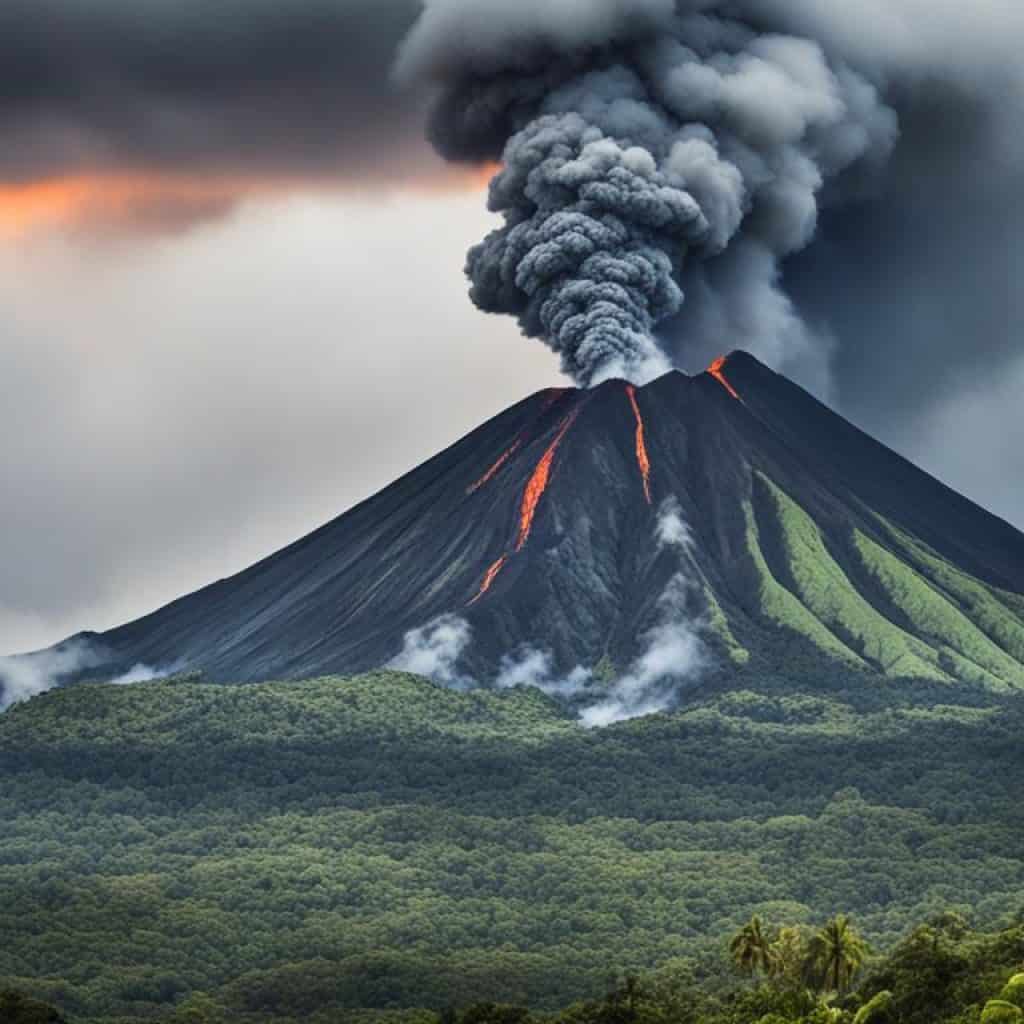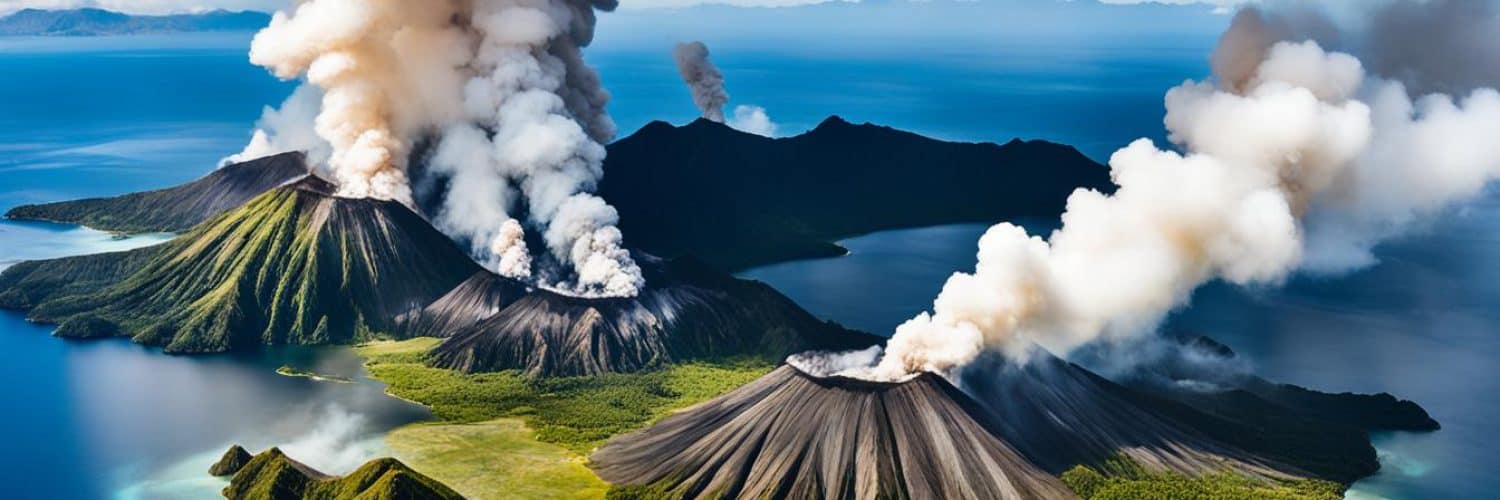Have you ever wondered why the Philippines is known as the “Ring of Fire”? With its abundant volcanic activity and stunning landscapes, this Southeast Asian archipelago is home to some of the most active volcanoes in the world. From the majestic Mayon Volcano to the intriguing Taal Volcano, the Philippines offers a captivating experience for adventure seekers and nature lovers alike. But how many of these active volcanoes can you name?
The Philippines boasts around 300 volcanoes, with 24 of them currently active. These awe-inspiring volcanoes are scattered throughout the country, creating a unique and dynamic volcanic landscape. So, are you ready to embark on a journey to discover the active volcanoes in the Philippines? Let’s explore!
Key Takeaways
- The Philippines is renowned for its active volcanoes, offering breathtaking landscapes and adventure opportunities.
- There are around 300 volcanoes in the country, with 24 of them currently active.
- Luzon, Visayas, and Mindanao are the main regions with active volcanoes in the Philippines.
- Mayon Volcano, Mt. Pinatubo, Taal Volcano, Mt. Arayat, Mt. Makiling, Mt. Kanlaon, and Mount Talinis are some of the most notable active volcanoes in the country.
- It’s crucial to be aware of safety measures and the current status of active volcanoes when visiting or residing near volcanic areas in the Philippines.
Volcanoes in Luzon
Luzon, the largest island in the Philippines, is home to several active volcanoes that offer breathtaking landscapes and attract many tourists. Some notable volcanoes in Luzon include:
- Mayon Volcano: Known for its perfect cone shape, Mayon Volcano in Albay province is one of the most famous and active volcanoes in the Philippines. It frequently erupts, showcasing its awe-inspiring power and beauty.
- Mt. Pinatubo: Situated in Zambales, Tarlac, and Pampanga provinces, Mt. Pinatubo gained international attention after its catastrophic eruption in 1991. Today, tourists can visit the volcano and hike to its crater, enjoying panoramic views of the surrounding landscape.
- Taal Volcano: Located in Batangas province, Taal Volcano is one of the world’s most unique and picturesque volcanoes. It features a stunning crater lake that captivates visitors with its beauty.
- Mt. Arayat: A dormant volcano in Pampanga province, Mt. Arayat offers mystical origins and picturesque landscapes. Hiking to its summit rewards adventurers with breathtaking views.
- Mt. Makiling: Straddling the provinces of Laguna and Batangas, Mt. Makiling is a dormant volcano that boasts lush forests and diverse flora and fauna. Visitors can hike the mountain and explore its natural attractions like the Makiling Botanic Gardens and natural springs.
These Luzon volcanoes showcase the immense power of nature and provide visitors with unique opportunities to experience the dynamic geological features of the Philippines.
“Nature’s beauty and power converge in Luzon’s active volcanoes, enchanting both locals and tourists alike.”
A Beautiful Table Title
| Volcano | Location | Features |
|---|---|---|
| Mayon Volcano | Albay Province | Perfect cone shape, frequent eruptions |
| Mt. Pinatubo | Zambales, Tarlac, and Pampanga provinces | Famous for 1991 eruption, scenic landscapes |
| Taal Volcano | Batangas Province | Crater lake, stunning views |
| Mt. Arayat | Pampanga Province | Dormant volcano, picturesque landscapes |
| Mt. Makiling | Laguna and Batangas provinces | Lush forests, biodiversity, natural attractions |
Volcanoes in the Visayas
The Visayas region in the Philippines is renowned for its breathtaking landscapes and is also home to several active volcanoes. Two prominent volcanoes in the region are Mt. Kanlaon and Mount Talinis, both located on the islands of Negros. These volcanoes offer exciting opportunities for hiking and exploring unique terrains.
The first volcano, Mt. Kanlaon, stands as the highest mountain in the Visayas region. It is an active stratovolcano that draws adventure enthusiasts from around the world. Located on the island of Negros, Mt. Kanlaon is surrounded by the Mount Kanlaon Natural Park, a recognized national park celebrated for its rich biodiversity.
The second volcano, Mount Talinis, also referred to as Cuernos de Negros, forms a volcanic complex in Negros Oriental. As the second-highest mountain in Negros, Mount Talinis offers an exhilarating hiking experience with stunning views of crater lakes and lush forests. The mountain is part of the Mount Talinis Range Natural Park, which adds to its charm and allure.
Exploring Mt. Kanlaon and Mount Talinis allows visitors to not only witness the beauty of the Visayas region but also appreciate the geological wonders and natural landscapes that make the Philippines a unique destination for outdoor enthusiasts.
Visiting the active volcanoes in the Visayas region is an unforgettable experience. The rugged beauty and diverse ecosystems of Mt. Kanlaon and Mount Talinis offer a glimpse into the geological wonders of the Philippines.
Volcanoes in Mindanao
Mindanao, the southernmost major island in the Philippines, is a captivating destination known for its natural beauty and vibrant culture. This diverse region is also home to several active volcanoes that add to its allure. Let’s explore some of the stunning volcanoes that grace the landscape of Mindanao.
1. Mt. Apo
As the highest peak in the Philippines, Mt. Apo stands majestically in Davao City. This stratovolcano offers breathtaking views and is a popular destination for hiking enthusiasts. The lush forests, cascading waterfalls, and diverse flora and fauna make it a paradise for nature lovers.
2. Mt. Matutum
Situated in South Cotabato, Mt. Matutum is another prominent volcano in Mindanao. With its lush vegetation and rich biodiversity, this stratovolcano attracts adventurers and nature enthusiasts alike. Hiking to its summit rewards visitors with panoramic views of the surrounding landscapes.
3. Mount Hibok-Hibok
Found in the picturesque island of Camiguin, Mount Hibok-Hibok is a stratovolcano that offers both scenic beauty and adventure. Hikers can explore its lush forests and witness the volcanic landscapes along the way. The island’s pristine white beaches and refreshing hot springs provide the perfect relaxation after an exhilarating hike.
These active volcanoes in Mindanao not only captivate with their natural beauty but also offer thrilling opportunities for adventure and exploration. From hiking to witnessing unique geological formations, visiting these volcanoes is an experience that should not be missed.
| Volcano | Location | Features |
|---|---|---|
| Mt. Apo | Davao City | Highest peak in the Philippines, lush forests, diverse flora and fauna |
| Mt. Matutum | South Cotabato | Lush vegetation, rich biodiversity, panoramic views |
| Mount Hibok-Hibok | Camiguin | Scenic beauty, lush forests, white beaches, hot springs |
Mayon Volcano (Albay)
Mayon Volcano, located in Albay province, is not only one of the most famous volcanoes in the Philippines but also an active one. It stands out with its remarkable perfect cone shape that captivates the imagination of both locals and tourists alike. The volcano is a testament to the country’s rich geological heritage and serves as a stunning backdrop to the surrounding landscapes.
Mayon Volcano is frequently featured in postcards, travel brochures, and social media feeds due to its picturesque beauty. Its majestic presence dominates the skyline and creates an impressive sight that leaves visitors in awe.
Visitors to Albay can indulge in a range of exciting activities to explore the beauty of Mayon Volcano. Adventurous souls can embark on thrilling ATV rides that take them through scenic trails, providing a unique perspective of the volcano. Hiking enthusiasts can trek to various vantage points that offer breathtaking views of the surrounding landscapes and the chance to witness Mayon’s raw power and natural wonder up close.
With its continuous volcanic activities, Mayon Volcano poses both a captivating and dynamic experience for travelers. While safety measures and precautions are always emphasized, the allure of witnessing an active volcano remains irresistible. The insights gained and memories made from visiting Mayon Volcano create a lasting impression and serve as a testament to the awe-inspiring forces of nature.
Mayon Volcano is a true wonder of nature, showcasing the raw power and beauty of an active volcano. It is a must-visit destination for anyone looking to experience the Philippines’ incredible landscape.
Immerse yourself in the enchanting presence of Mayon Volcano, explore its surroundings, and let its beauty leave an indelible mark on your journey through the Philippines.
| Elevation | Location | Last Eruption |
|---|---|---|
| 2,462 meters | Albay province, Luzon, Philippines | January 13, 2018 |
Mt. Pinatubo (Zambales)
Famous for its explosive eruption in 1991, Mt. Pinatubo is a well-known volcano located in Zambales, Tarlac, and Pampanga provinces. This majestic volcano attracts tourists from all over the world who are eager to witness its natural wonders.
Visitors can embark on a thrilling hike to the crater of Mt. Pinatubo, where they can marvel at the stunning views of the surrounding landscapes. The hike takes adventurers through canyons and sandy riverbeds, creating a truly memorable experience.
In addition to the exhilarating hike, Mt. Pinatubo offers scenic landscapes that captivate the senses. From the rugged terrain to the lush greenery, every step unveils the breathtaking beauty of this volcano.
After a day of exploration, travelers can unwind and relax in the hot springs near Mt. Pinatubo. These natural hot springs provide a soothing retreat, allowing visitors to rejuvenate their bodies and minds.
Discover the natural wonders of Zambales and witness the grandeur of Mt. Pinatubo. It is a tourist spot that offers adventure, serenity, and awe-inspiring landscapes.
Key Highlights of Mt. Pinatubo:
- Spectacular hike to the crater
- Breathtaking views of the surrounding landscapes
- Scenic landscapes with rugged terrain and lush greenery
- Relaxation in natural hot springs
Taal Volcano (Batangas)
Taal Volcano, located in Batangas province, is a mesmerizing natural wonder that attracts visitors from all over the world. What makes Taal Volcano truly unique is its magnificent crater lake, which is often hailed as one of the most breathtaking sights in the Philippines.
Although trekking to the volcano’s crater might be restricted at the moment, tourists can still experience the awe-inspiring beauty of Taal from the nearby city of Tagaytay. Perched on a ridge, Tagaytay offers panoramic views of the volcano and its stunning surroundings.

Taal Volcano’s crater lake, set within the volcano’s crater, captivates visitors with its ethereal beauty. Formed through centuries of volcanic activity, the lake sparkles with clear turquoise waters, creating a picturesque backdrop against the steep walls of the crater. The serene beauty of the crater lake is truly a sight to behold.
While trekking to the crater may not be possible currently, there are other activities that visitors can enjoy in the area. Tagaytay is known for its cool climate, scenic landscapes, and delectable local cuisine. Visitors can indulge in delightful dishes while taking in the mesmerizing views of Taal Volcano.
“Taal Volcano’s crater lake is a true marvel of nature, enchanting visitors with its stunning colors and serene ambiance. It’s an experience that will stay with you forever.” – Local Travel Magazine
Nearby Attractions in Tagaytay
| Attraction | Description |
|---|---|
| Taal Vista Hotel | A historic hotel known for its panoramic views of Taal Volcano and Lake |
| Sky Ranch | A popular amusement park with thrilling rides and a sky eye panoramic wheel |
| Picnic Grove | A scenic park where visitors can enjoy picnics, horseback riding, and zipline adventures |
| Puzzle Mansion | A museum featuring a vast collection of jigsaw puzzles |
| Sonya’s Garden | A charming bed and breakfast known for its beautiful gardens and sumptuous organic meals |
Exploring the wonders of Taal Volcano from the vantage point of Tagaytay City is an unforgettable experience. Whether it’s enjoying the scenic view, savoring delicious local food, or indulging in exciting activities, a visit to Taal Volcano and Tagaytay promises to create cherished memories.
Mt. Arayat (Pampanga)
A hidden gem in Pampanga province, Mt. Arayat offers a unique hiking experience with its mystical origins and breathtaking landscapes. This dormant volcano is a favorite among outdoor enthusiasts and nature lovers.
Hiking to the summit of Mt. Arayat rewards adventurers with panoramic views of the surrounding area, including lush forests, rolling hills, and picturesque fields. The trail offers a moderate challenge, making it suitable for both novice and experienced hikers.
Along the way, hikers may encounter various species of flora and fauna, adding to the allure of the journey. The volcano is home to a diverse range of plant life, including rare orchids and mossy forests.
After a rewarding hike, visitors can relax and unwind at the natural pools and picnic grounds surrounding Mt. Arayat. These tranquil spots provide an opportunity to rejuvenate and reconnect with nature.
Whether you’re a seasoned hiker or a nature enthusiast looking for a peaceful getaway, Mt. Arayat in Pampanga is a must-visit destination. Immerse yourself in the beauty of the volcano, explore its trails, and create unforgettable memories in this enchanting natural wonder.
| Location | Elevation | Attractions |
|---|---|---|
| Pampanga, Philippines | 1,026 meters (3,366 feet) | Natural pools, picnic grounds, diverse flora and fauna |
Mt. Makiling (Laguna & Batangas)
Mt. Makiling is a dormant volcano located in the provinces of Laguna and Batangas in the Philippines. This majestic volcano is known for its lush forests, making it a popular destination for nature lovers and hikers. The forest reserve surrounding Mt. Makiling is home to a diverse range of flora and fauna, including rare species that are endemic to the area.
Hiking up Mt. Makiling provides an opportunity to immerse yourself in the beauty of its surroundings, as well as enjoy breathtaking views from the summit. Along the way, you can explore attractions like the Makiling Botanic Gardens, which showcase the rich plant life found on the volcano. The gardens offer a peaceful retreat, with various trails and gardens to explore.
Another highlight of Mt. Makiling is its natural springs, which are believed to have therapeutic properties. These springs provide a soothing experience for visitors who want to relax and rejuvenate amidst the tranquil environment of the volcano. Whether you’re looking for an adventure or a serene escape, Mt. Makiling offers a unique experience for every visitor.
ASEAN Heritage Park Designation
Mt. Makiling has been designated as an ASEAN Heritage Park, recognizing its ecological significance and the need for its protection. The volcano serves as a habitat for numerous plant and animal species, some of which are considered endangered. The ASEAN Heritage Park designation highlights the importance of preserving the natural treasures found on Mt. Makiling.
| Key Highlights of Mt. Makiling | Location | Attractions | Designation |
|---|---|---|---|
| • Lush forests and diverse flora and fauna | • Laguna & Batangas provinces | • Makiling Botanic Gardens | • ASEAN Heritage Park |
| • Hiking trails and breathtaking views | • Natural springs | ||
Mt. Kanlaon (Negros)
Located on the picturesque island of Negros, Mt. Kanlaon stands as the highest mountain in the Visayas region. This majestic peak is an active stratovolcano that beckons adventurous hikers to experience its thrilling trails and breathtaking vistas. Blessed with unspoiled natural beauty, Mt. Kanlaon offers an unforgettable hiking experience amidst its lush landscapes and captivating terrain.
Surrounding Mt. Kanlaon is the renowned Mount Kanlaon Natural Park, a designated national park that showcases the region’s rich biodiversity. Visitors can revel in the diverse flora and fauna as they explore the trails of this protected area. From vibrant orchids to endemic bird species, the park offers a haven for nature enthusiasts and wildlife lovers.
To fully immerse in the beauty of Mt. Kanlaon, hikers can embark on a variety of trails catering to different skill levels. Whether you are a seasoned trekker or a novice adventurer, there is a trail suited for you. An experienced guide is recommended to ensure a safe and rewarding journey to the summit.
Prepare to be awe-inspired as you ascend Mt. Kanlaon. The sweeping views of the surrounding landscape, the crisp mountain air, and the sense of accomplishment when you reach the pinnacle are truly unforgettable.
Trail Options:
1. Wasay-Guintubdan Trail
2. Mapot-Mananawin Trail
3. Mambucal-Nailig Trail
Important Reminders:
- Observe safety precautions and pack necessary hiking gear.
- Check the weather conditions and volcanic activity before embarking on your hike.
- Respect the natural surroundings and practice responsible tourism.
Hiking in Negros offers a unique opportunity to witness the raw power and beauty of Mt. Kanlaon. As you conquer its trails, you will not only discover the wonders of nature but also gain a deeper appreciation for the resilience of the Philippines’ volcanic landscape.

| Trail | Difficulty Level | Distance | Estimated Hiking Time |
|---|---|---|---|
| Wasay-Guintubdan | Intermediate | 12.5km | 6-8 hours |
| Mapot-Mananawin | Advanced | 16km | 8-10 hours |
| Mambucal-Nailig | Expert | 20km | 10-12 hours |
Mount Talinis (Negros Oriental)
Mount Talinis, also known as Cuernos de Negros, is a volcanic complex located in Negros Oriental. Standing as the second-highest mountain in Negros, it offers an exhilarating hiking experience for outdoor enthusiasts and adventurers.
This majestic mountain is situated within the Mount Talinis Range Natural Park, a protected area that showcases the stunning beauty of crater lakes and lush forests. Exploring Mount Talinis allows hikers to immerse themselves in the rich biodiversity and natural wonders of Negros Oriental.
With its challenging yet rewarding trails, Mount Talinis is a popular destination for hiking in Negros Oriental. Hikers can embark on various routes that cater to different levels of experience, providing opportunities to explore the diverse flora and fauna that thrive in this volcanic landscape.
Ascending Mount Talinis rewards hikers with breathtaking views of the surrounding mountains, forests, and shimmering lakes. The most notable attractions include the picturesque Twin Lakes of Balinsasayao and Balanan, where visitors can marvel at the tranquil beauty of the crater lakes nestled within the verdant slopes of the volcano.
“Embark on a journey up Mount Talinis and discover the raw beauty of Negros Oriental’s volcanic landscape.”
Whether you are an experienced hiker seeking a thrilling adventure or a nature lover looking to immerse yourself in the captivating beauty of Negros Oriental, Mount Talinis offers a memorable experience for all. The challenging trails, awe-inspiring views, and untouched wilderness make it a must-visit destination for hiking enthusiasts.
| Mount Talinis (Cuernos de Negros) | Negros Oriental, Philippines |
|---|---|
| Hiking Difficulty | Challenging |
| Elevation | 1,903 meters (6,243 feet) |
| Trailhead | Dumaguete City or Valencia, Negros Oriental |
| Key Attractions | Twin Lakes of Balinsasayao and Balanan, Crater Lakes, Breathtaking Views |
Volcano Alert Levels in the Philippines
The Philippine Institute of Volcanology and Seismology (PHIVOLCS) plays a crucial role in monitoring volcanic activities in the Philippines. With a focus on ensuring the safety of residents and tourists, PHIVOLCS assigns alert levels to each volcano based on their current state. These alert levels serve as essential indicators for assessing the potential hazards associated with volcanic eruptions.
Volcanic activities in the Philippines can vary from low-level unrest to more hazardous events. By categorizing volcanoes with different alert levels, PHIVOLCS effectively communicates the level of risk to the general public. This information allows individuals to make informed decisions regarding their safety and well-being.
Understanding the volcano alert levels implemented by PHIVOLCS is crucial for both residents and tourists when planning travel or residing near volcanic areas. By staying informed and prepared, individuals can mitigate potential risks and ensure their safety in the event of volcanic activities.
| Alert Level | Description |
|---|---|
| Alert Level 0 | Quiet |
| Alert Level 1 | Low-level seismic unrest |
| Alert Level 2 | Increased unrest, potential eruption possible within weeks or months |
| Alert Level 3 | Magmatic unrest, eruption possible within days or weeks |
| Alert Level 4 | Hazardous eruption imminent or ongoing |
| Alert Level 5 | Catastrophic eruption in progress |
These alert levels provide valuable guidance for both locals and visitors, enabling them to stay updated on volcano safety measures. PHIVOLCS continuously monitors volcanic activities in the Philippines, ensuring that the public receives timely and accurate information to make well-informed decisions.
Safety and Volcanic Activities in the Philippines
The Philippines, situated in the Pacific Ring of Fire, is prone to natural disasters including volcanic eruptions, earthquakes, and typhoons. For both residents and tourists, it is crucial to prioritize safety measures and be prepared in case of volcanic activities. Understanding the status of active volcanoes plays a vital role in making informed decisions when living in or visiting volcanic areas.
Volcano Safety Tips
- Stay informed: Monitor updates and advisories from the Philippine Institute of Volcanology and Seismology (PHIVOLCS) to keep abreast of volcanic activities.
- Create an emergency plan: Develop a clear plan with your family or travel group in case of a volcanic eruption. Determine evacuation routes, emergency meeting points, and communication channels.
- Prepare an emergency kit: Assemble essential supplies such as food, water, medication, flashlights, and batteries.
- Follow evacuation orders: If authorities issue evacuation orders, comply immediately for your safety.
- Avoid restricted areas: Respect and adhere to the designated safety zones and restricted areas near active volcanoes.
- Protect yourself from volcanic ash: Use masks or cover your nose and mouth with a cloth to minimize inhalation of fine ash particles.
- Be cautious of volcanic hazards: Stay away from areas prone to lahars (volcanic mudflows), pyroclastic flows, and volcanic gas emissions.
- Stay updated on weather conditions: Monitor weather forecasts as volcanic eruptions can potentially trigger adverse weather conditions.
- Seek reliable information: Rely on official sources and avoid spreading unverified information or rumors during volcanic events.
Quote:
“Safety should always be the top priority when dealing with natural disasters like volcanic eruptions. Staying informed, prepared, and following evacuation orders can significantly reduce the risks and ensure the well-being of everyone affected.” – PHIVOLCS
Volcanoes and Natural Disasters in the Philippines
The Philippines is no stranger to natural disasters, with volcanic eruptions being one of the most significant threats. The country’s unique geographical location makes it susceptible to frequent volcanic activities. It is essential to respect and understand the power of nature, taking necessary precautions to stay safe from volcanic hazards.

Conclusion
The Philippines is a stunning destination that showcases a magnificent volcanic landscape. With a plethora of active volcanoes scattered throughout the country, it truly is a natural wonder. From the perfect cone shape of Mayon Volcano to the mesmerizing beauty of Taal Volcano’s crater lake, these geological marvels never fail to captivate visitors.
Exploring the active volcanoes in the Philippines provides a unique opportunity to witness the country’s dynamic and awe-inspiring natural wonders. The volcanic landscapes offer breathtaking views, picturesque hiking trails, and adventurous activities like ATV rides and hot spring indulgence. It’s an experience that immerses travelers in the raw beauty of nature.
As you journey through the Philippine volcanic landscape, you’ll encounter not only the power of nature but also the rich culture and history that surrounds these active volcanoes. The locals have embraced their volcanic heritage and have built vibrant communities around these majestic mountains.
Whether you’re an adventure enthusiast, a nature lover, or a cultural explorer, the active volcanoes in the Philippines beckon you to embark on an unforgettable journey. Discover the beauty of the Philippine volcanic landscape and witness firsthand the natural wonders that make this country a truly remarkable destination.


















Add comment